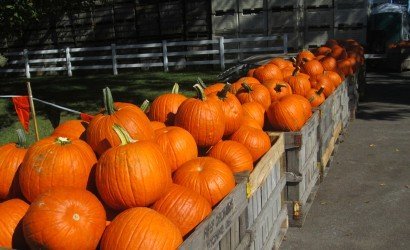At our recent Day Trip to the Ward Museum, we timed our tour perfectly to catch a panel discussion on the recent snowy owl irruption on the Shore. The discussion was led by Cindy P. Driscoll, a wildlife veterinarian for the Maryland Department of Natural Resources, David F. Brinker, a wildlife ecologist for the Maryland Department of Natural Resources and Carrie Samis, an Education Coordinator with the Maryland Coastal Bays Program. While participating in this special gathering of dozens of fellow bird lovers, ShoreBread learned all about our white feathered visitors on the Shore.
Brinker kicked off the discussion by telling the story of how Project SNOWstorm, a mission to gather information about snowy owls, got its start. Brinker visits Maryland every year to do research on the saw-whet owl, a small bird that migrates to our beaches around Thanksgiving every year. Because the bird migrates around Turkey Day, Brinker’s family joins him on Assateague every year as he does research over the holiday. During this past year’s trip, the researcher and his family were driving away from the site when they spotted three snowy owls within a very small distance. Since snowy owls are generally a rare occurrence in our area, the unusual sightings clued Brinker in that a natural development was taking place.
Soon snowy owls were becoming easy for everyone to spot. Other researchers recorded 138-206 sightings of the bird within just one week. Birds were seen all across the Eastern Shore, sitting on the Bay Bridge and even in D.C. Brinker realized that this feathered phenomenon was an excellent opportunity to do research and decided to take action. Many friends and associates were asked to help the cause and a website was set up to gather donations; within 13 days the site had collected $20,000.
Part of the reason why there were so many donations, Samis explained, is because the project is at a cross roads of science, social media and pop culture. People quickly began posting pictures on social media sites of the birds that they had seen and someone even made a twitter account for the snowy owl spotted in D.C., which currently has 1,240 followers. An important factor to the public’s support is also the role of a snowy owl in the Harry Potter movies. Samis commented that because there was a young generation who recognized the snowy owl from the movies, they were more familiar with the bird and, as such, had a higher interest when it flew to our area. Luckily, this combination of influences caused the project to gather enough momentum, donations and volunteers to get the proverbial wind beneath its wings.
One thing we learned while in the meeting was that there is very little that we know about snowy owls, which is why it is so important to take advantage of this unique opportunity to learn about them. Live owls are collected by a couple of different methods, such as using a cage that is baited with a live rodent (who also lives at the end of the capture) and a technique that uses nets to fall while the bird is in flight. The owls that are brought in for research are often measured for height and weight and typically have a blood sample taken.
After the birds have been studied, they are equipped with a small transmitter that will track the birds’ migration patterns. These tiny solar panel trackers were described by Brinker as, “a combination of GPS and a cellphone.” Every three days, the snowy owls’ GPS coordinates are sent to researchers’ computers and can be mapped out. The progress of the birds can be seen on the Project SNOWstorm website. From the information already gathered, scientists have been able to track the snowy owls movements at night while they hunt sleeping waterfowl and other owls that have fallen asleep on ice floes and drifted to a new location.
Scientists also gather information from necropsies, or dead snowy owls. With these birds, research such as toxicology levels and stomach contents can be studied, information that would otherwise be impossible to glean from a live bird. Unfortunately, because many of the migrating birds are young and because close to 60 percent of snowy owls will die within the first year of their lives, you may see a few dead snowy owls on the Eastern Shore. However, if you happen to see an injured or lifeless bird, be sure to contact the state wildlife agency. In Maryland you are instructed to call 1-877-463-6497.
At the meeting, we were also able to finally get some information about why all of these birds of prey are flocking to our area this year. To understand the reasoning, we have to first understand snowy owl populations and prey patterns. Snowy owls breed and live part of their lives north of the Arctic Circle, where the majority of their diet consists of rodents called lemmings. Snowy owls have a way of detecting how big or small the lemming population will be each year and the owls will adjust the number of eggs they lay accordingly.
This past year must have been a particularly huge lemming population explosion because the number of snowy owl offspring was enormous. As a result, all of these young birds were pushed from their arctic homes by older owls and have been forced to find food elsewhere until winter is over and it becomes too hot for them to live in our local climate. The owls not only stay close to the coast to catch fish and waterfowl, but they also prefer to spend their time in environments that have few trees or mountains, and our beaches just so happen to provide this ideal landscape.
As the discussion came to a close and the slideshow of beautiful pictures of the white feathered birds continued to scroll past the audiences’ eyes, Samis’ description of the snowy owl as a “charismatic” bird really rang true for us. Needless to say, from the scientific opportunity for study to the beauty of the bird, we at ShoreBread are glad that the snowy owl decided to visit us at home this year.
**Photo by Kim Zimmerman*









